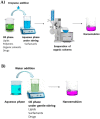Current Applications of Nanoemulsions in Cancer Therapeutics
- PMID: 31159219
- PMCID: PMC6632105
- DOI: 10.3390/nano9060821
Current Applications of Nanoemulsions in Cancer Therapeutics
Abstract
Nanoemulsions are pharmaceutical formulations composed of particles within a nanometer range. They possess the capacity to encapsulate drugs that are poorly water soluble due to their hydrophobic core nature. Additionally, they are also composed of safe gradient excipients, which makes them a stable and safe option to deliver drugs. Cancer therapy has been an issue for several decades. Drugs developed to treat this disease are not always successful or end up failing, mainly due to low solubility, multidrug resistance (MDR), and unspecific toxicity. Nanoemulsions might be the solution to achieve efficient and safe tumor treatment. These formulations not only solve water-solubility problems but also provide specific targeting to cancer cells and might even be designed to overcome MDR. Nanoemulsions can be modified using ligands of different natures to target components present in tumor cells surface or to escape MDR mechanisms. Multifunctional nanoemulsions are being studied by a wide variety of researchers in different research areas mainly for the treatment of different types of cancer. All of these studies demonstrate that nanoemulsions are efficiently taken by the tumoral cells, reduce tumor growth, eliminate toxicity to healthy cells, and decrease migration of cancer cells to other organs.
Keywords: cancer; multifunctional nanoemulsions; targeted delivery.
Conflict of interest statement
The authors declare no conflict of interest.
Figures
References
-
- McClements D.J. Nanoemulsions versus microemulsions: Terminology, differences, and similarities. Soft Matter. 2012;6:1719–1729. doi: 10.1039/C2SM06903B. - DOI
-
- Gi H.J., Chen S.N., Hwang J.S., Tien C., Kuo M.T. Studies of Formation and Interface of Oil-Water Microemulsion. Chin. J. Phys. 1992;30:665–678.






